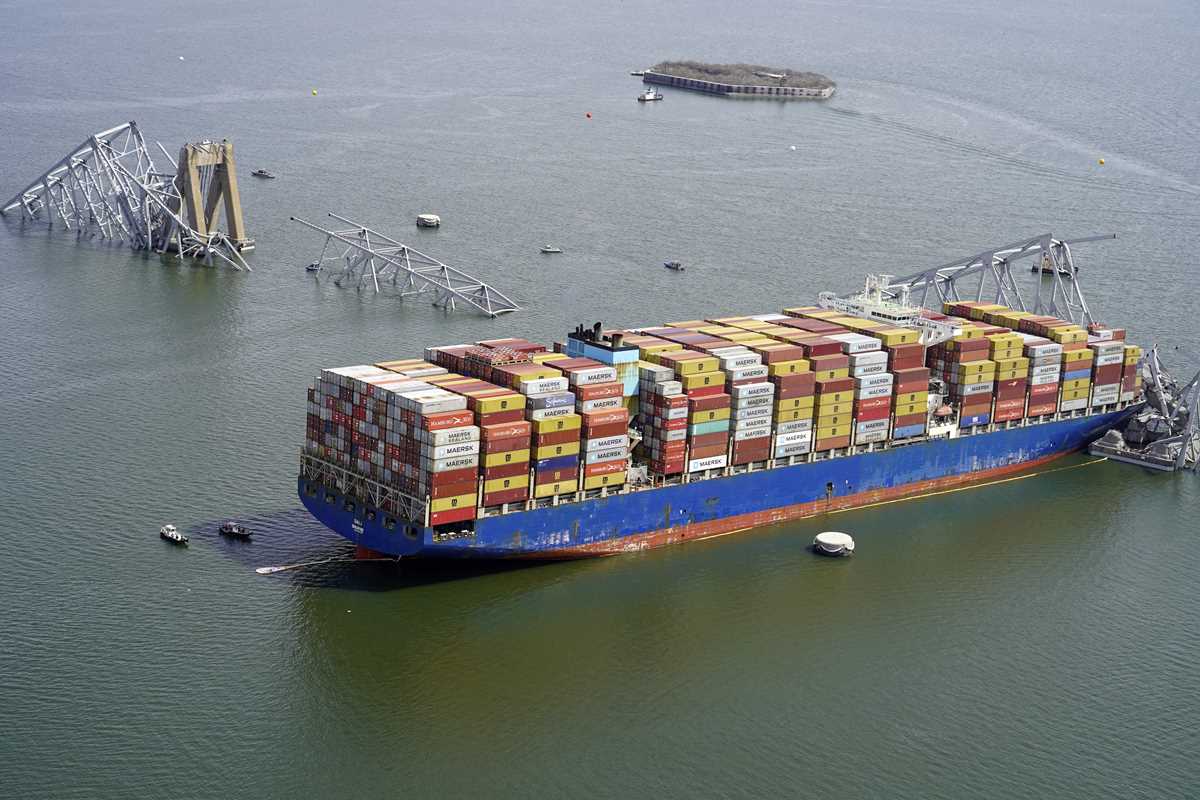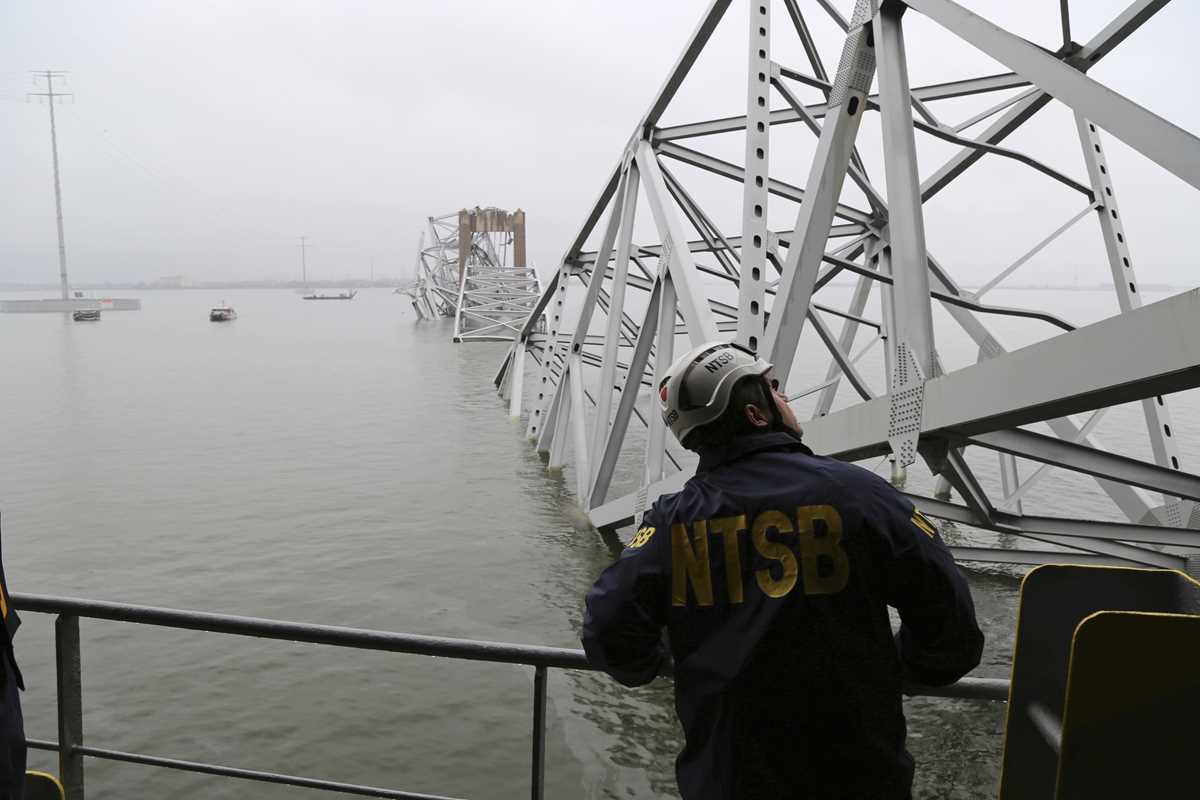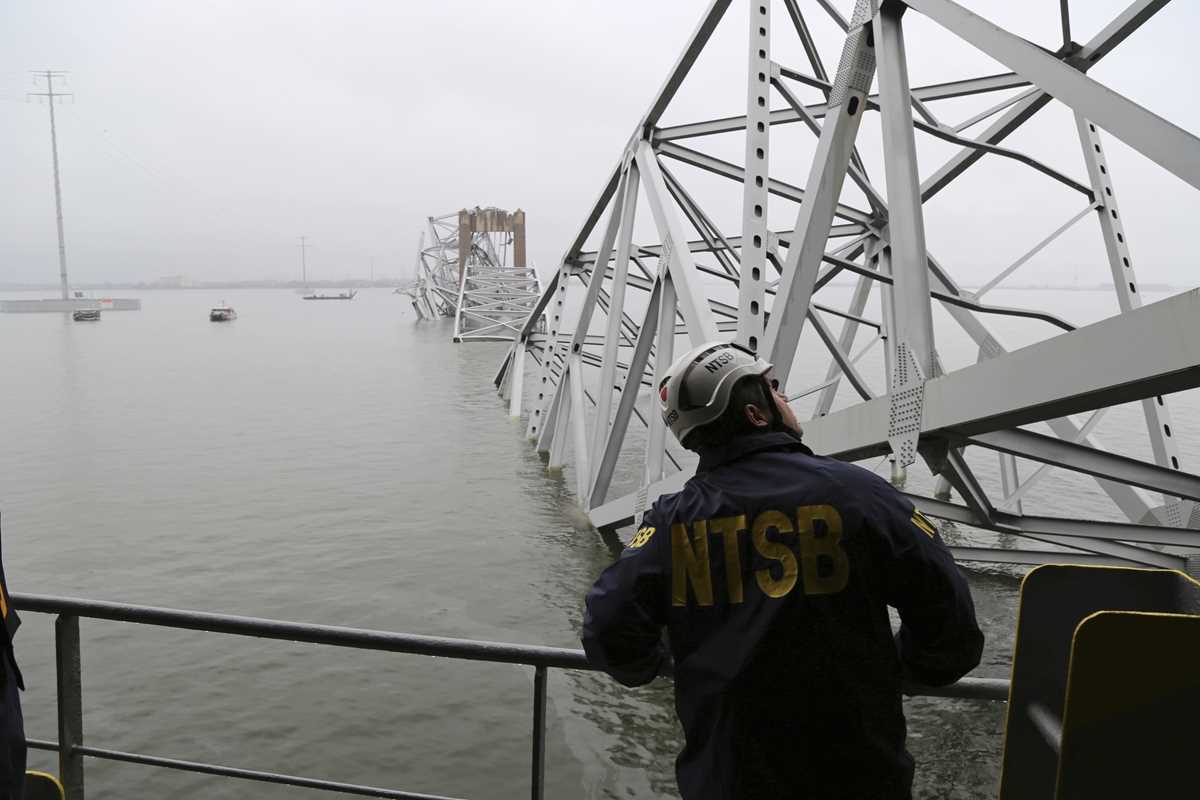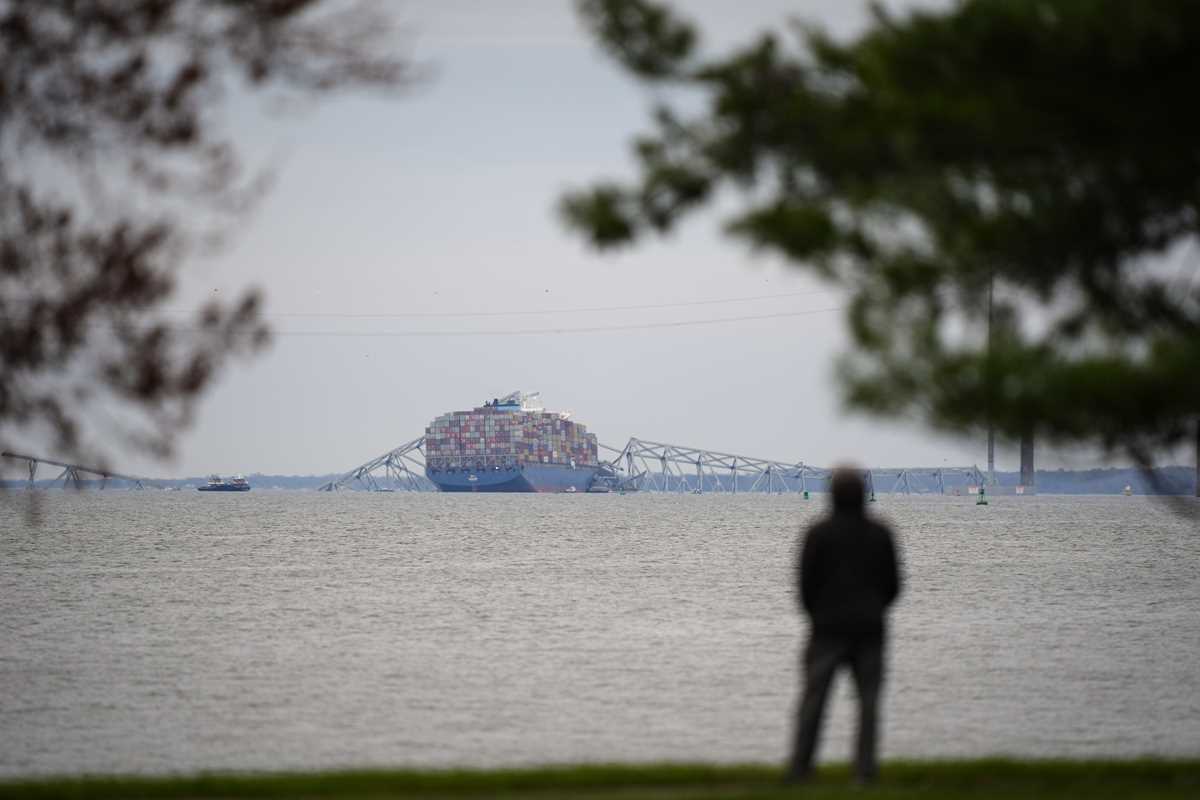 A container ship rests against the wreckage of the Francis Scott Key Bridge on Thursday, March 28, 2024, in Baltimore, Md. After days of searching through murky water for the workers missing after the bridge collapsed, officials are turning their attention Thursday to what promises to be a massive salvage operation. (AP Photo/Matt Rourke)
A container ship rests against the wreckage of the Francis Scott Key Bridge on Thursday, March 28, 2024, in Baltimore, Md. After days of searching through murky water for the workers missing after the bridge collapsed, officials are turning their attention Thursday to what promises to be a massive salvage operation. (AP Photo/Matt Rourke) In this image released by the National Transportation and Safety Board, NTSB investigators on the cargo vessel Dali, which struck and collapsed the Francis Scott Key Bridge, Wednesday, March 27, 2024 in Baltimore. (Peter Knudson/NTSB via AP)
In this image released by the National Transportation and Safety Board, NTSB investigators on the cargo vessel Dali, which struck and collapsed the Francis Scott Key Bridge, Wednesday, March 27, 2024 in Baltimore. (Peter Knudson/NTSB via AP) A container ship rests against the wreckage of the Francis Scott Key Bridge on Thursday, March 28, 2024, in Baltimore, Md. After days of searching through murky water for the workers missing after the bridge collapsed, officials are turning their attention Thursday to what promises to be a massive salvage operation. (AP Photo/Matt Rourke)
A container ship rests against the wreckage of the Francis Scott Key Bridge on Thursday, March 28, 2024, in Baltimore, Md. After days of searching through murky water for the workers missing after the bridge collapsed, officials are turning their attention Thursday to what promises to be a massive salvage operation. (AP Photo/Matt Rourke) A container ship rests against the wreckage of the Francis Scott Key Bridge on Thursday, March 28, 2024, in Baltimore, Md. After days of searching through murky water for the workers missing after the bridge collapsed, officials are turning their attention Thursday to what promises to be a massive salvage operation. (AP Photo/Matt Rourke)
A container ship rests against the wreckage of the Francis Scott Key Bridge on Thursday, March 28, 2024, in Baltimore, Md. After days of searching through murky water for the workers missing after the bridge collapsed, officials are turning their attention Thursday to what promises to be a massive salvage operation. (AP Photo/Matt Rourke) A container ship rests against the wreckage of the Francis Scott Key Bridge on Thursday, March 28, 2024, in Baltimore, Md. After days of searching through murky water for the workers missing after the bridge collapsed, officials are turning their attention Thursday to what promises to be a massive salvage operation. (AP Photo/Matt Rourke)
A container ship rests against the wreckage of the Francis Scott Key Bridge on Thursday, March 28, 2024, in Baltimore, Md. After days of searching through murky water for the workers missing after the bridge collapsed, officials are turning their attention Thursday to what promises to be a massive salvage operation. (AP Photo/Matt Rourke)The patchwork system of safety regulations pertaining to massive cargo ships like the one that toppled a major bridge in Baltimore this week can allow freight transporters to skirt oversight, critics say, making maritime shipping what one expert called “the weakest link in the transportation system.”
The thousands of container ships that carry more than 80% of all goods moved around the world are governed by rules established by the International Maritime Organization in London that are enforced by the various countries where ships are based and ports across the world. And many ships fly the flags of so-called countries of convenience that offer cheap registration fees and tax breaks but may not have robust oversight.
“There’s no strong infrastructure for safety in maritime," said Jim Hall, who led the National Transportation Safety Board from 1994 to 2001. "And there’s a lack of adequate oversight of what we have because the Coast Guard is essentially underfunded and doesn’t have the adequate manpower to do the many jobs it is given to do.”
Former U.S. Rep. Peter DeFazio of Oregon, who chaired the House Transportation Committee and tried to improve regulations for decades before leaving office last year, said the system encourages ship owners to seek out “the least-regulated place in the world and the cheapest labor that you can exploit and make money.”
“The only protections we have are harbor inspections when ships come to the U.S. Otherwise, it’s a pretty much unregulated, Wild West industry,” DeFazio said.
But regulators and ship owners defend the safety of the industry because regardless of where a ship is based, it's still supposed to meet the same standards that countries and ports enforce through periodic inspections. Records show that the the ship that struck the bridge in Baltimore — the Dali — was last inspected by the U.S. Coast Guard in New York on Sept. 13. According to data from the shipping information website Equasis, the “standard examination” didn’t identify any deficiencies. That was one of at least 27 inspections the ship underwent at ports around the world since it was built in 2015.
Given the huge amount of freight delivered around the world by some 90,000 ships of all sizes, relatively few accidents are reported, according to the International Chamber of Shipping coalition of ship owners. Insurer Allianz Global said only 38 vessels were lost in 2022, which is down significantly from the 1990s, when more than 200 ships were routinely lost each year.
“The maritime mode of transportation merchant shipping is an incredibly, incredibly safe mode of transportation, not just here in the United States, but worldwide," U.S. Coast Guard Vice Admiral Peter Gautier said during a White House briefing Wednesday.
The Dali was flagged in Singapore, which has one of the best safety records of any country where ships are based. It's not listed as one of the 42 countries identified as “flags of convenience” by the International Transport Workers Federation. Authorities in Singapore have said they will conduct their own investigation into the bridge collapse and help U.S. authorities get information they need from the ship's management company, Synergy Marine Group.
Aside from a problem where the pressure gauges for the Dali's fuel heaters were found to be illegible last June during an inspection in Chile and a 2016 collision in Belgium when it struck a berth used for mooring vessels in the port of Antwerp, the ship doesn't appear to have had many issues, according to Equasis.
But another ship that was owned by the Dali's owner, Grace Ocean, was banned from Australian ports for six months in 2021 after authorities there discovered it had been underpaying its workers and keeping them on board for months after their contracts expired. The 13 workers on the Western Callao were owed tens of thousands of dollars. Even though Grace Ocean owned both ships, a different company managed the Western Callao at the time.
University of Rhode Island Professor Douglas Hales said the Port of Baltimore has a strong set of regulations that appear to have been followed in this incident. That includes when the Dali's crew issued a mayday call after the ship lost power just before striking one of the bridge’s columns. That warning allowed authorities to stop vehicles from driving onto the bridge.
“There doesn’t appear to be anything that the port administration could have done to prevent this,” Hales said. “This appears to be a failure of the navigation system after the vessel left the port. And so far, there hasn't been anyone that said that there was an incident before the vessel left the port that people just ignored.”
The National Transportation Safety Board will determine if that's the case as part of its investigation into the cause of the bridge collapse, but it will be more than a year before the agency issues its final report.
Eight construction workers who were filling potholes went into the water when the bridge collapsed, and two were quickly rescued. Searchers found the bodies of two workers on Wednesday, and the other four are presumed dead.
Roland Rexha, the secretary treasurer of the oldest maritime union in the country, the Marine Engineers' Beneficial Association, said it takes a major disaster like the fiery train derailment in eastern Ohio last year or the panel flying off of a Boeing 737 Max plane midflight in January before the public realizes there is a problem in the transportation industries.
He said that with maritime shipping being the oldest transportation industry, with its international regulations that rely on many different countries for enforcement, it may have the most problems.
“When I talk about those other transportation industries, the maritime industry is the worst offender of safety violations, of labor violations than any other industry,” Rexha said.
___
Associated Press writers Michael Kunzelman and Seung Min Kim contributed to this report.
Before you make your next trade, you'll want to hear this.
MarketBeat keeps track of Wall Street's top-rated and best performing research analysts and the stocks they recommend to their clients on a daily basis.
Our team has identified the five stocks that top analysts are quietly whispering to their clients to buy now before the broader market catches on... and none of the big name stocks were on the list.
They believe these five stocks are the five best companies for investors to buy now...
See The Five Stocks Here
Do you expect the global demand for energy to shrink?! If not, it's time to take a look at how energy stocks can play a part in your portfolio.
Get This Free Report